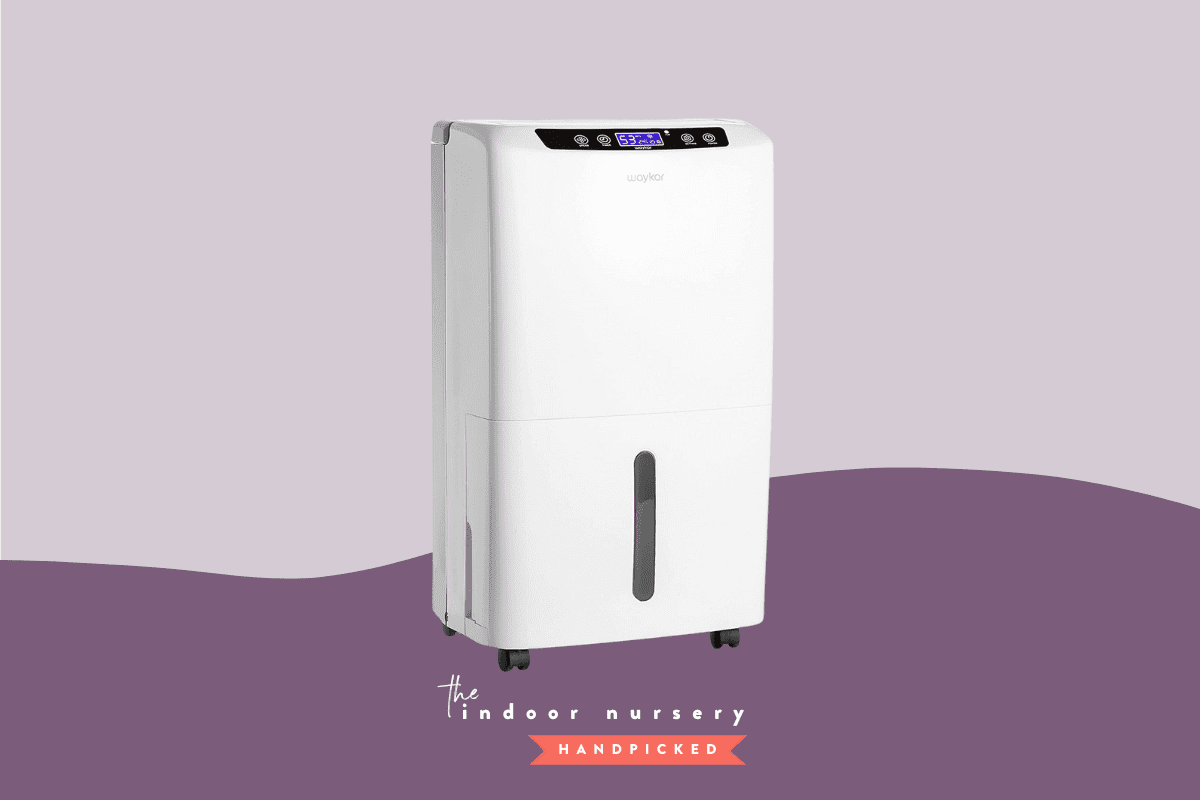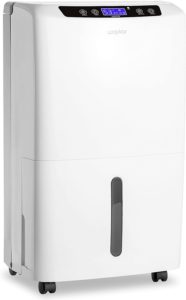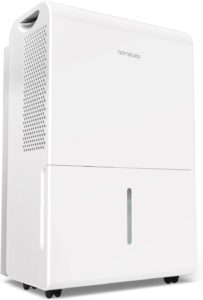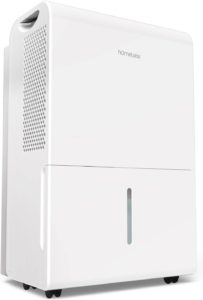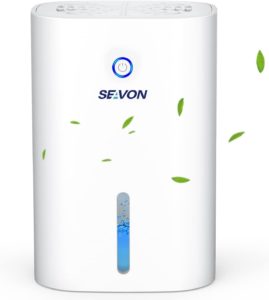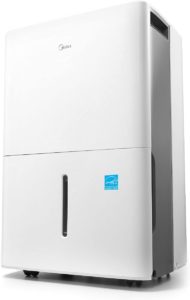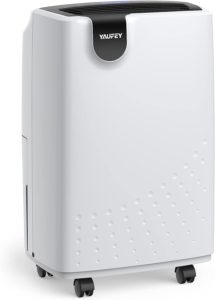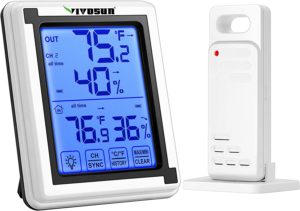🧪 Our review process
Our testing team independently researches, tests, and recommends the best products to help keep your houseplants absolutely thriving. Learn more about our testing and review process here.
Looking for the best dehumidifier for grow tent operations, large and small? Well, I’m here to help you find something that’s reliable, energy efficient, and easy to use.
I’ll also walk you through relative humidity and what the ideal humidity levels are for your grow tent.
Our top picks
Here are some of the best grow tent dehumidifiers for growing plants indoors, whether they’re exotic jungle plants or a fresh crop of cannabis.
1. BEST DEHUMIDIFIER FOR GROW TENT: Waykar 2000 Sq. Ft Dehumidifier
A powerful dehumidifier for large grow rooms and tents.
Product Specs
- Covers up to 2000 sq. ft.
- 0.66 gallons tank capacity
- Auto shut-off
Designed to cover up to 2000 sq. ft, it’s perfect for larger grow tents. For optimal temperature and humidity levels, especially for cannabis or exotic plants, running it for about 10-12 hours daily should suffice. Depending on the size of your plants and their water needs, this unit can comfortably handle a tent with 20-30 plants, ensuring they thrive in the right conditions.
But if that’s too small for you, you can choose from five different sizes, all the way up to 150 pints (7,000 sq.ft.).
Pros
- Suitable for large tents
- Quiet operation
- User-friendly interface
Cons
- Bulkier design takes up space
- Might be over budget for some
- Requires regular emptying
2. BEST FOR LARGE GROW TENTS: hOmeLabs 4500 Sq. Ft Energy Star Dehumidifier
A powerhouse dehumidifier for large grow tents.
Product Specs
- Can dehumidify up to 4500 sq. ft.
- Efficient moisture removal
- Hassle-free drainage without emptying the tank
The hOmeLabs 4500 Sq. Ft Energy Star Dehumidifier is a top-tier choice for those serious about their indoor gardening. With its ability to cover up to 4500 sq. ft., it’s perfect for larger grow tents or even multiple tents in proximity.
The built-in pump compressor ensures that excess moisture is removed efficiently, helping to prevent mold, pests, and other humidity-related issues. However, its size might be a bit overkill for smaller setups.
Pros
- Large coverage area
- Efficient moisture removal
- Continuous drainage option
Cons
- Might be overkill for small tents
- Takes up more space
- Higher price point
3. BEST FOR MEDIUM GROW TENTS: hOmeLabs 1500 Sq. Ft. Energy Star Dehumidifier
A powerful dehumidifier for medium-sized grow tents.
Product Specs
- Covers up to 1500 sq. ft.
- Efficient power usage
- Hassle-free water removal, but hose sold separately
Designed to cover up to 1500 sq. ft. It’s perfect for medium-sized tents. The device is energy-efficient, ensuring you don’t get a spike in your electricity bill. However, it might be a bit overkill for smaller tents, and the continuous drainage option requires an additional hose purchase.
Pros
- Quickly reduces humidity
- User-friendly controls
- Minimal noise disturbance
Cons
- Might be overkill
- For continuous drainage
- Takes up more space
4. BEST FOR SMALL GROW TENTS: SEAVON Dehumidifiers for Home, 2200 Cubic Feet (215 sq ft)
A compact dehumidifier perfect for small grow tents.
Product Specs
- Lightweight and easy to move around
- Compact size fits easily in small spaces
- 27oz capacity suitable for smaller grow tents
The SEAVON Dehumidifier is a compact and quiet unit, ideal for small grow tents up to 215 sq ft. This mini dehumidifier is the perfect solution to absorb moisture and control humidity levels without taking up too much space. This is the best dehumidifier for indoor plants and hobbyists.
For optimal results, it should run for about 10-12 hours daily. Given its capacity, it’s best suited for tents with 4-6 plants.
Pros
- Quiet operation
- Energy-efficient
- Auto-shutoff feature
Cons
- Not for larger tents
- Manual drainage
- No built-in hygrometer
5. BEST FOR HUMIDITY CONTROL: Midea 1,500 Sq. Ft. Energy Star Certified Dehumidifier
The ideal choice for maintaining desired humidity level.
Product Specs
- Suitable for up to 1,500 sq. ft.
- Efficient power usage
- Reusable air filter
The Midea 1,500 Sq. Ft. Energy Star Certified Dehumidifier is perfect for medium-sized grow tents, keeping your plants healthy and happy. With its water tank capacity, it’s recommended to run it for about 6-8 hours daily to maintain optimal humidity levels. Depending on your plant density, it can efficiently handle a tent with up to 20 plants.
Pros
- Perfect size for most home gardeners
- Energy efficient
- Easy maintenance
Cons
- Might be insufficient for bigger setups
- Requires regular cleaning
- Slightly Noisy
6. BEST FOR LOW MAINTENANCE: Yaufey 2500 Sq. Ft Home Dehumidifier
The ideal choice for maintaining optimal humidity in medium-sized grow tents.
Product Specs
- Covers up to 2500 sq. ft.
- 1.8L water tank capacity
- Hassle-free draining experience
The Yaufey 2500 Sq. Ft Home Dehumidifier is a fantastic choice for home gardeners, especially those using medium-sized grow tents. It’s designed to cover an area up to 2500 sq. ft, making it perfect for tents around 8×10 feet or slightly larger. For those cultivating exotic plants or cannabis, maintaining the right humidity level is crucial. This unit can run for about 12-14 hours a day to ensure your plants thrive in a healthy environment. Depending on the size and type of plants, it can handle a tent with up to 20-25 plants efficiently.
Pros
- Efficient for medium tents
- Less frequent emptying required
- Continuous draining
Cons
- Not for larger tents
- Slightly noisy operation
- Bulkier design.
Our verdict
My top two picks are: Waykar 2000 Sq. Ft Dehumidifier for reliability and Yaufey 2500 Sq. Ft Home Dehumidifier for automating a lot of the process (AKA save you time).
Our recommendations
| # | Preview | Product | |
|---|---|---|---|
| 1. | BEST DEHUMIDIFIER FOR GROW TENT: Waykar 2000 Sq. Ft Dehumidifier | View on Amazon | |
| 2. | BEST FOR LARGE GROW TENTS: hOmeLabs 4500 Sq. Ft Energy Star Dehumidifier | View on Amazon | |
| 3. | BEST FOR MEDIUM GROW TENTS: hOmeLabs 1500 Sq. Ft. Energy Star Dehumidifier | View on Amazon | |
| 4. | BEST FOR SMALL GROW TENTS: SEAVON Dehumidifiers for Home, 2200 Cubic Feet (215 sq ft) | View on Amazon | |
| 5. | BEST FOR HUMIDITY CONTROL: Midea 1,500 Sq. Ft. Energy Star Certified Dehumidifier | View on Amazon | |
| 6. | BEST FOR LOW MAINTENANCE: Yaufey 2500 Sq. Ft Home Dehumidifier | View on Amazon |
How To Choose The Right Size Dehumidifier For Grow Tent
If a plant consumes half a gallon of water daily, a grow room with 10 plants will use 5 gallons, equivalent to 40 pints. This means your grow room will absorb about 1.6 pints of moisture from the air every hour. A pint of water weighs roughly the same as a pound of moisture.
Over a 24 hour period, over 38 pints of moisture will need to be collected from the air.
You can fit 10 plants in a 4×4 grow tent, so a 50 pint dehumidifier is a good fit.
Dehumidifiers vary in size, typically ranging from 30 to 300 pints.
Let’s break down the requirements based on this assumption:
Given:
- 10 plants in a 4×4 grow tent produce about 38 pints of moisture over 24 hours.
- A 4×4 grow tent is 16 square feet in area (assuming a height of 1 foot for simplicity).
Using this as a reference, we can extrapolate for other tent sizes:
This is some basic math to size up your grow tent dehumidifier needs. This isn’t an exact science and a lot can vary depending on what your grow tent setup is. BUT that being said, here’s generally what you’re looking at, depending on your grow tent size:
2×2 Grow Tent (4 square feet):
- Houses 2.5 plants (10 plants / 16 square feet * 4 square feet).
- Produces about 9.5 pints of moisture over 24 hours (38 pints / 10 plants * 2.5 plants).
- Recommended Dehumidifier: At least 12 pints (to cover moisture and provide a buffer), covering 4 cubic feet.
3×3 Grow Tent (9 square feet):
- Houses 5.6 plants (10 plants / 16 square feet * 9 square feet).
- Produces about 21.3 pints of moisture over 24 hours (38 pints / 10 plants * 5.6 plants).
- Recommended Dehumidifier: At least 25 pints, covering 9 cubic feet.
4×4 Grow Tent (16 square feet):
- Houses 10 plants.
- Produces about 38 pints of moisture over 24 hours.
- Recommended Dehumidifier: 50 pints, covering 16 cubic feet.
5×5 Grow Tent (25 square feet):
- Houses 15.6 plants (10 plants / 16 square feet * 25 square feet).
- Produces about 59.5 pints of moisture over 24 hours (38 pints / 10 plants * 15.6 plants).
- Recommended Dehumidifier: At least 65 pints, covering 25 cubic feet.
6×6 Grow Tent (36 square feet):
- Houses 22.5 plants (10 plants / 16 square feet * 36 square feet).
- Produces about 85.5 pints of moisture over 24 hours (38 pints / 10 plants * 22.5 plants).
- Recommended Dehumidifier: At least 90 pints, covering 36 cubic feet.
7×7 Grow Tent (49 square feet):
- Houses 30.6 plants (10 plants / 16 square feet * 49 square feet).
- Produces about 116.3 pints of moisture over 24 hours (38 pints / 10 plants * 30.6 plants).
- Recommended Dehumidifier: At least 125 pints, covering 49 cubic feet.
8×8 Grow Tent (64 square feet):
- Houses 40 plants (10 plants / 16 square feet * 64 square feet).
- Produces about 152 pints of moisture over 24 hours (38 pints / 10 plants * 40 plants).
- Recommended Dehumidifier: At least 160 pints, covering 64 cubic feet.
9×9 Grow Tent (81 square feet):
- Houses 50.6 plants (10 plants / 16 square feet * 81 square feet).
- Produces about 192.3 pints of moisture over 24 hours (38 pints / 10 plants * 50.6 plants).
- Recommended Dehumidifier: At least 200 pints, covering 81 cubic feet.
10×10 Grow Tent (100 square feet):
- Houses 62.5 plants (10 plants / 16 square feet * 100 square feet).
- Produces about 237.5 pints of moisture over 24 hours (38 pints / 10 plants * 62.5 plants).
- Recommended Dehumidifier: At least 250 pints, covering 100 cubic feet.
Remember, these are estimates based on the assumption that plant water consumption and moisture production scale linearly with tent size. Adjustments may be needed based on specific plant types and other environmental factors.
What To Know Before You Buy A Grow Tent Dehumidifier
Whether you’re a houseplant enthusiast aiming for that perfect Monstera leaf or a cannabis grower seeking the highest yield, maintaining the right humidity is key.
Picking the right dehumidifier isn’t just about moisture control; it’s about giving your plants the best environment to ✨flourish✨. Here’s what you need to know.
The Ideal Humidity Levels
Relative humidity, often abbreviated as RH, is a term that describes the amount of moisture present in the air compared to the maximum amount it could hold at a given temperature. Think of it like this: if the air is holding half the moisture it could potentially hold, the relative humidity would be 50%.
Now, why does this matter for your grow tent? Well, too much humidity can lead to mold, mildew, and other unwanted issues, while too little can dry out your plants and hinder their growth. Whether you’re nurturing your houseplants or cultivating cannabis, understanding and controlling RH is key to creating the perfect environment for your plants to thrive.
But, how much moisture is needed in the air, what’s the ideal humidity level?
For houseplant hobbyists, most of your leafy companions, like ferns, philodendrons, and orchids, thrive in a humidity range of 50% to 70%. If you’re nurturing tropical plants, they especially love the higher end of this range. On the other hand, cacti and succulents prefer it a bit drier, around 40% to 50%.
For cannabis growers, the game changes a bit based on the growth stage:
- Seedling stage: Aim for 65% to 70% humidity. This mimics the moist environment seeds naturally germinate in.
- Vegetative stage: A range of 50% to 70% is ideal. Young cannabis plants love a bit of moisture!
- Flowering stage: Here, you’ll want to reduce it to 40% to 50%. Too much humidity during this stage can lead to mold issues on those precious buds.
To keep a close eye on these levels, invest in a digital hygrometer. It’s a small tool that’ll be your best friend in ensuring your plants get the environment they deserve.
Adjustable Humidity Settings
Different plants, different needs. Houseplants might enjoy a bit of high humidity, while cannabis plants require specific levels during various growth stages. An adjustable setting ensures every plant gets its ideal environment.
Continuous Drainage Option
Dehumidifiers extract moisture from the air, collecting it in a built-in water tank. While many models require manual emptying of this water tank, some offer a continuous drain option, allowing for automatic water expulsion. This feature can be especially convenient for locations where regular manual emptying isn’t practical.
Some dehumidifiers come equipped with a drain hose, while others might necessitate a separate purchase. If you opt for a model with continuous draining but it doesn’t include a hose, you’ll need to buy one.
Typically, there’s a designated drain port on the dehumidifier to attach the hose, which should then lead to a suitable drain point like a floor drain or sink. It’s essential to ensure the hose runs downward without obstructions for smooth water flow. For added flexibility, high-end models might even feature a built-in pump to direct water upward if needed. Always consult the specific model’s user manual for precise guidance.
Automatic Shut Off Feature
The “Auto Shut-off and Alerts” feature in dehumidifiers enhances both safety and user convenience. Auto shut-off automatically powers down the dehumidifier once its water tank is full, preventing potential overflows and water damage. This is particularly beneficial for those who can’t constantly monitor the unit.
Complementing this, the alert system, often through indicator lights or alarms, notifies users when the tank needs emptying. Some advanced models might even integrate with smart home systems, sending notifications to devices. Together, these features ensure efficient operation while minimizing the risk of water-related issues and reducing the need for frequent manual checks.
Energy Efficiency
When selecting an energy-efficient dehumidifier, it’s essential to consider its size relative to the area you intend to dehumidify, as well as features like a built-in humidistat, automatic shut-off, and low-temperature operation. A washable air filter and energy-saving modes can further enhance efficiency.
The Energy Star rating, a program by the U.S. EPA and Department of Energy, signifies that a product meets strict energy-efficiency guidelines. Dehumidifiers with this label use at least 15% less energy than non-certified models, offering both cost savings and a reduced environmental impact without compromising performance.
Tips For Using Dehumidifier In Your Grow Tent
Follow the instructions manual on your chosen dehumidifier for best results. When using dehumidifiers, it really comes down to three things:
- Position your dehumidifier in a spot where it can circulate air efficiently. Avoid corners or tight spaces where airflow might be restricted.
- Just like your plants need care, so does your dehumidifier. Clean the filters regularly and ensure it’s free from dust and debris to keep it running smoothly.
- Don’t just set it and forget it. Keep an eye on your grow tent’s humidity levels. Adjust the settings on your dehumidifier as needed, especially during different growth stages or seasonal changes.
FAQs
Navigating the world of grow tents can be a bit overwhelming, especially when it comes to maintaining the perfect environment for your plants. Whether you’re a houseplant enthusiast or a cannabis cultivator, you’ve probably pondered over the role of dehumidifiers and ventilation.
Let’s dive into some frequently asked questions to clear the air (pun intended!).
Is 60% humidity OK in a grow tent?
For most plants, yes. However, cannabis prefers 40-50% during flowering to prevent bud rot.
Where should I place the dehumidifier in the grow tent?
Place it in a central location for even distribution, ensuring it doesn’t obstruct airflow or light.
How big of a dehumidifier do I need for my grow tent?
It depends on tent size and relative humidity levels. Generally, a 30-pint unit works for small to medium tents. Always check the manufacturer’s recommendations.
Is ventilation better than a dehumidifier?
Both serve different purposes. Ventilation ensures fresh air circulation, while dehumidifiers control moisture levels.
Should you use a dehumidifier in a grow tent?
Yes, especially in humid conditions. It helps prevent mold and optimizes plant growth.
Can a dehumidifier replace ventilation?
No, plants need fresh air. A dehumidifier controls humidity, but ventilation ensures CO2 and oxygen exchange.
Do I need ventilation in my grow tent?
Absolutely! Ventilation provides fresh air, regulates temperature, and prevents mold.
Conclusion
The best grow tent dehumidifier removes excess moisture, prioritizes energy efficiency, has low energy costs, and has an auto shut off feature. Getting desired humidity levels in your grow tent is just around the corner with one of these top picks!
Shop our recommendations
- The Best Hydroponic Tower For Indoor Gardening
- 10 Best Worm Composter Bins For Easy Homemade Compost
- The Best pH Meter For Soil
- The 6 Best Dehumidifiers For Grow Tents
- The Best Complete Indoor Hydroponic Grow System
- 5 Best Grow Light Strips For Indoor Plants
- TESTED: Aerogarden vs Click and Grow Smart Garden
- Our *hands on* MARS HYDRO TSW 2000 review (with photos)
- 7 Best Hygrometers For Indoor Plants
- The Best Coco Coir For Your Plant’s Healthiest Root System Ever

